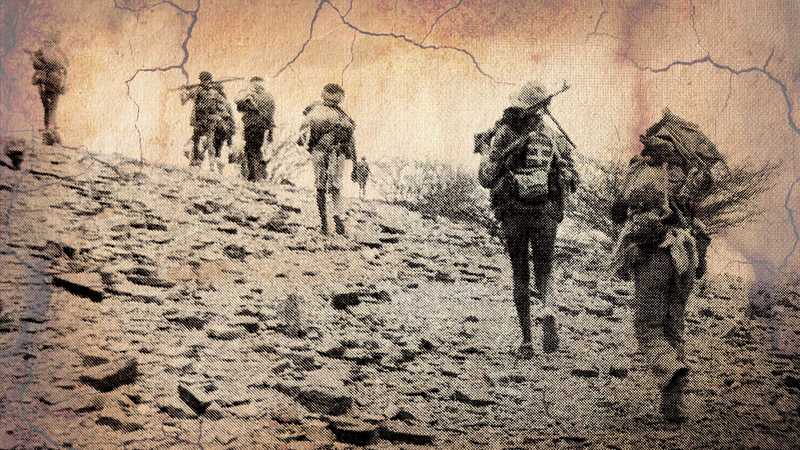The Retreat of ELF and EPLF from Eritrean towns
In June of 1978
In mid-1978, the Eritrean revolution faced a decisive moment when the military balance of power shifted. A strategic withdrawal was made.
 EPLF freedom fighters - Tegadelti - marching up a hill
EPLF freedom fighters - Tegadelti - marching up a hill
In mid-1978, the Eritrean revolution faced a critical juncture. The military balance of power had shifted, with the Derg regime in Ethiopia preparing a massive, well-armed offensive to crush the resistance once and for all. Outgunned and outmanned, the Eritrean People’s Liberation Front (EPLF) made the strategic decision to withdraw its forces, regroup, and prepare for a protracted battle. This article will examine the context, details, and implications of this pivotal moment in Eritrea’s struggle for independence.
The Derg’s Overwhelming Offensive
In June 1978, the Derg regime launched an unprecedented offensive against Eritrean revolutionary forces in Asmara and other besieged cities. The invading army was immense, totaling over 120,000 troops organized into task forces 501, 502, 503, 505, and 506. The Derg’s military might included:
- 38 infantry brigades
- 6 mechanized brigades
- 10 artillery battalions
- A modern navy with advanced warships
- An air force with over 5 squadrons of jet fighters
Additional troops were poised to join the assault on key cities like Asmara, Massawa, and Adi Keyh (Adi Qeyi’H). The Derg aimed to deliver a decisive blow to the Eritrean revolution.
The Limited Capacities of ELF and EPLF
In stark contrast to the Derg’s overwhelming numbers, the EPLF’s forces were spread thin across multiple fronts. The EPLF could field only:
- 8 infantry brigades
- 1 heavy weapons brigade
- Just over 15,000 combat troops
The Eritrean Liberation Front (ELF) had comparable manpower. From the Derg’s vantage point, these modest EPLF forces surrounded Asmara to the north, west, east and south. The port city of Massawa was partly under Derg’s control, with a front line in the city itself. To the north and south of Adi Keyh, the EPLF had established defensive lines.
While Gash-Barka region remained fully under the control of Eritrean revolutionary forces, with the ELF besieging Barentu, the Eritreans’ military potential was a fraction of the Derg’s, and divided across an array of battlefronts. A conventional confrontation appeared impossible.
New Threats on All Fronts
Determined to vanquish the Eritrean revolution in one fell swoop, the Derg opened up new attack routes to supplement their existing positions:
- From Gondar via Humera to Umm Hajar (Om Hajer)
- From Shire via Adi-Daero to Barentu
- From Adwa to Mereb and Adi Quala (Adi Kuala) via Rama to Gerhu Sirnay and Tserona
The Derg forces already in place in Asmara, Massawa and Adi Keyh mobilized to coordinate with these new lines of attack. The Eritrean revolutionary forces were at risk of being completely surrounded and overwhelmed.
The Strategic Withdrawal
Faced with this dire situation, the EPLF leadership made the difficult but necessary decision to withdraw to more favorable terrain where they could regroup, resupply and wage a drawn-out guerrilla war against the Derg. Directly engaging the enemy’s superior numbers and firepower in conventional battles would have been suicidal.
By pulling back in an orderly fashion, the EPLF aimed to:
- Preserve the gains and ideals of the revolution
- Protect its limited manpower and resources
- Extend the conflict and exhaust the Derg
- Gather strength for an eventual counteroffensive
This strategic withdrawal was a crucial pivot point that likely saved the Eritrean revolution from total defeat. It demonstrated the EPLF’s military savvy, discipline and commitment to the long struggle ahead.
Conclusion
The EPLF’s strategic withdrawal in mid-1978 was a vital response to the Derg’s massive military onslaught. Outmatched in numbers and equipment, directly confronting the Derg’s invasion would have meant the swift destruction of the Eritrean revolution. By trading territory for time and shifting to guerrilla tactics, the EPLF ensured the survival of the independence movement and laid the groundwork for the protracted people’s war that would ultimately lead to victory. The events of 1978 underscore the resilience, adaptability and unwavering resolve of the Eritrean resistance in the face of overwhelming odds. It stands as a key turning point in Eritrea’s long march to freedom.
